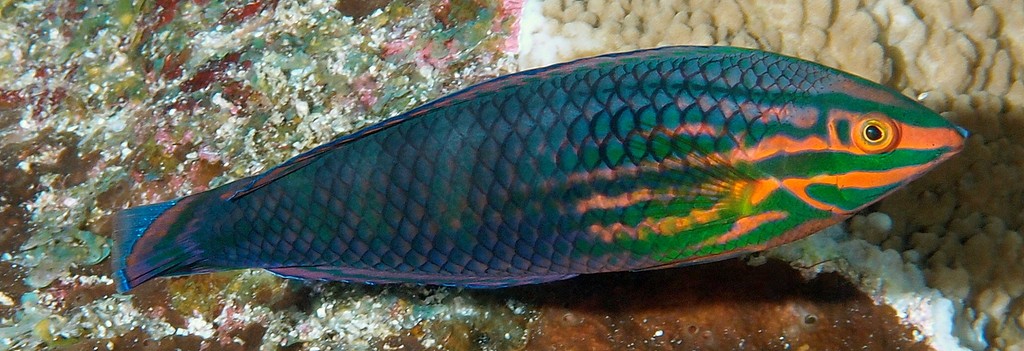HALICHOERES BIOCELLATUS - (SCHULTZ, 1960)
Actinopterygii (Gigaclass) > Actinopteri (Class) > Teleostei (Subclass) > Labriformes (Order) > Labroidei (Suborder) > Labridae (Family) > Halichoeres (Genus)
Labre à deux ocelles, Biocellate wrasse, False-eyed wrasse, Red-lined wrasse, Redlined wrasse, Two-spotted wrasse, Twospot wrasse, Nishiki-kyûsen, ニシキキュウセン, 双斑海猪鱼, 双睛斑海猪鱼,
Description
Dorsal spines (total): 9; Dorsal soft rays (total): 12; Anal spines: 3; Anal soft rays: 11-12; Pectoral fin rays: 13; Lateral line scales: 27, the scales with a single pore; Body depth: 2.9-3.35 in SL; Head scaless; Scales on thorax notably smaller than those of rest of body; Preopercular margin free as much ventrally as posteriorly; A single pair of canines anteriorly in each jaw; A canines at corner of mouth. Max. length: 12.0 cm TL. Depth range: 1 - 50 m, usually: 6 - 35 m.
Color
Juveniles (initial phase) have a series of orange, green and white stripes on the sides, a pair of ocelli on the dorsal fin, and a small black spot on the upper part of the caudal-fin base.
Females (intermediate phase) are more colorful with pink, blue, and purple stripes on the body, and a pair of ocelli on the dorsal fin.
Males (terminal phase) are generally greenish-brown with orange and green stripes on the head that become greenish-brown bands on the rear of the body.
Etymology
Halichoeres: from Greek, halio-, hali-, halo-, hal- = word-forming element meaning "salt, sea," a Greek combination form of hals (genitive halos) "a lump of salt, salt generally," in Homer, "the sea," + from Greek, choiros = pig. Referring to elongated conical tooth at each corner of mouth, pointed outwards and forwards, and usually protruding beyond the flesh of lips, which reminded Rüppell of the canine teeth of a boar; Here "hog of the sea or hogfish".
biocellatus: from Latin, bis = two or twice + from Latin, occelatus = having small eyes or an eyelike marking in the form of a spot or ring of color, as on the wing of a butterfly or the tail of a peacock. Referring to pair of ocellate black spots on dorsal fin of juveniles and females.
Original description: Halichoeres biocellatus Schultz, 1960 - Type locality: lagoon at Arji Island, Bikini Atoll, western Pacific, depth: 20-40 feet.
Distribution
Indo-West Pacific: Indonesia, east to Micronesia and Samoa, north to Amami Islands (southern Japan), south to Australia and New Caledonia.
Biology
Found in samll groups in areas of mixed coral and reef rock with sand patches. Also in reef crests and slopes on rocky or rubble-algae substrates. Traded in the aquarium industry.
Last udpate: 7, April 2023
Labre à deux ocelles, Biocellate wrasse, False-eyed wrasse, Red-lined wrasse, Redlined wrasse, Two-spotted wrasse, Twospot wrasse, Nishiki-kyûsen, ニシキキュウセン, 双斑海猪鱼, 双睛斑海猪鱼,
Description
Dorsal spines (total): 9; Dorsal soft rays (total): 12; Anal spines: 3; Anal soft rays: 11-12; Pectoral fin rays: 13; Lateral line scales: 27, the scales with a single pore; Body depth: 2.9-3.35 in SL; Head scaless; Scales on thorax notably smaller than those of rest of body; Preopercular margin free as much ventrally as posteriorly; A single pair of canines anteriorly in each jaw; A canines at corner of mouth. Max. length: 12.0 cm TL. Depth range: 1 - 50 m, usually: 6 - 35 m.
Color
Juveniles (initial phase) have a series of orange, green and white stripes on the sides, a pair of ocelli on the dorsal fin, and a small black spot on the upper part of the caudal-fin base.
Females (intermediate phase) are more colorful with pink, blue, and purple stripes on the body, and a pair of ocelli on the dorsal fin.
Males (terminal phase) are generally greenish-brown with orange and green stripes on the head that become greenish-brown bands on the rear of the body.
Etymology
Halichoeres: from Greek, halio-, hali-, halo-, hal- = word-forming element meaning "salt, sea," a Greek combination form of hals (genitive halos) "a lump of salt, salt generally," in Homer, "the sea," + from Greek, choiros = pig. Referring to elongated conical tooth at each corner of mouth, pointed outwards and forwards, and usually protruding beyond the flesh of lips, which reminded Rüppell of the canine teeth of a boar; Here "hog of the sea or hogfish".
biocellatus: from Latin, bis = two or twice + from Latin, occelatus = having small eyes or an eyelike marking in the form of a spot or ring of color, as on the wing of a butterfly or the tail of a peacock. Referring to pair of ocellate black spots on dorsal fin of juveniles and females.
Original description: Halichoeres biocellatus Schultz, 1960 - Type locality: lagoon at Arji Island, Bikini Atoll, western Pacific, depth: 20-40 feet.
Distribution
Indo-West Pacific: Indonesia, east to Micronesia and Samoa, north to Amami Islands (southern Japan), south to Australia and New Caledonia.
Biology
Found in samll groups in areas of mixed coral and reef rock with sand patches. Also in reef crests and slopes on rocky or rubble-algae substrates. Traded in the aquarium industry.
Last udpate: 7, April 2023
